CLT教学法相关介绍
- 格式:doc
- 大小:30.50 KB
- 文档页数:2
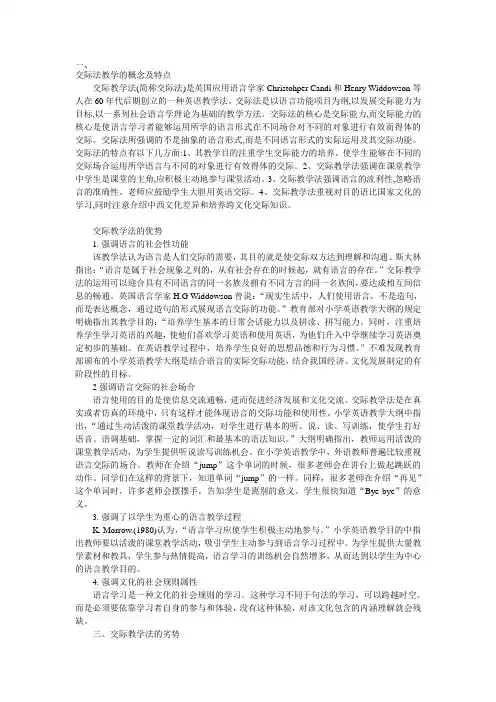
一、交际法教学的概念及特点交际教学法(简称交际法)是英国应用语言学家Christohper Candi和Henry Widdowson等人在60年代后期创立的一种英语教学法。
交际法是以语言功能项目为纲,以发展交际能力为目标,以一系列社会语言学理论为基础的教学方法。
交际法的核心是交际能力,而交际能力的核心是使语言学习者能够运用所学的语言形式在不同场合对不同的对象进行有效而得体的交际。
交际法所强调的不是抽象的语言形式,而是不同语言形式的实际运用及其交际功能。
交际法的特点有以下几方面:1、其教学目的注重学生交际能力的培养。
使学生能够在不同的交际场合运用所学语言与不同的对象进行有效得体的交际。
2、交际教学法强调在课堂教学中学生是课堂的主角,应积极主动地参与课堂活动。
3、交际教学法强调语言的流利性,忽略语言的准确性。
老师应鼓励学生大胆用英语交际。
4、交际教学法重视对目的语比国家文化的学习,同时注意介绍中西文化差异和培养跨文化交际知识。
交际教学法的优势1. 强调语言的社会性功能该教学法认为语言是人们交际的需要,其目的就是使交际双方达到理解和沟通。
斯大林指出:“语言是属于社会现象之列的,从有社会存在的时候起,就有语言的存在。
”交际教学法的运用可以迎合具有不同语言的同一名族及拥有不同方言的同一名族间,要达成相互间信息的畅通。
英国语言学家H.G Widdowson曾说:“现实生活中,人们使用语言,不是造句,而是表达概念,通过造句的形式展现语言交际的功能。
”教育部对小学英语教学大纲的规定明确指出其教学目的:“培养学生基本的日常会话能力以及拼读、拼写能力。
同时,注重培养学生学习英语的兴趣,使他们喜欢学习英语和使用英语,为他们升入中学继续学习英语奠定初步的基础。
在英语教学过程中,培养学生良好的思想品德和行为习惯。
”不难发现教育部颁布的小学英语教学大纲是结合语言的实际交际功能,结合我国经济、文化发展制定的有阶段性的目标。
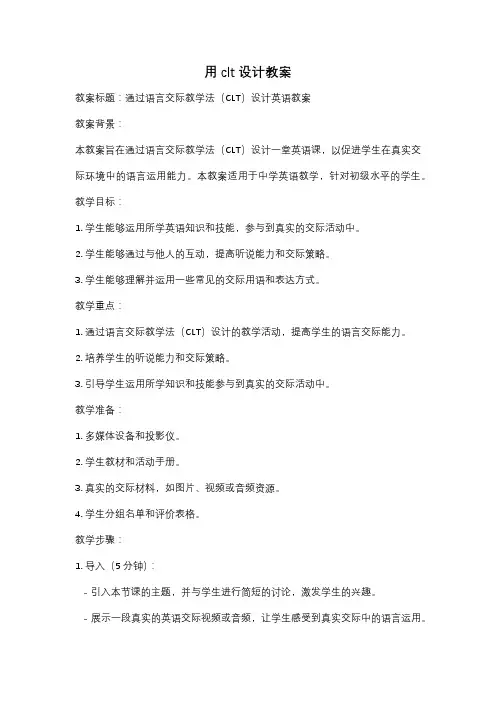
用clt设计教案教案标题:通过语言交际教学法(CLT)设计英语教案教案背景:本教案旨在通过语言交际教学法(CLT)设计一堂英语课,以促进学生在真实交际环境中的语言运用能力。
本教案适用于中学英语教学,针对初级水平的学生。
教学目标:1. 学生能够运用所学英语知识和技能,参与到真实的交际活动中。
2. 学生能够通过与他人的互动,提高听说能力和交际策略。
3. 学生能够理解并运用一些常见的交际用语和表达方式。
教学重点:1. 通过语言交际教学法(CLT)设计的教学活动,提高学生的语言交际能力。
2. 培养学生的听说能力和交际策略。
3. 引导学生运用所学知识和技能参与到真实的交际活动中。
教学准备:1. 多媒体设备和投影仪。
2. 学生教材和活动手册。
3. 真实的交际材料,如图片、视频或音频资源。
4. 学生分组名单和评价表格。
教学步骤:1. 导入(5分钟):- 引入本节课的主题,并与学生进行简短的讨论,激发学生的兴趣。
- 展示一段真实的英语交际视频或音频,让学生感受到真实交际中的语言运用。
2. 学习活动(30分钟):- 将学生分成小组,并给每个小组分配一个真实生活场景,如购物、旅行等。
- 要求学生在小组内进行角色扮演,模拟真实交际情境。
- 提供相关的交际用语和表达方式,帮助学生进行对话。
- 教师在小组活动中引导学生,提供必要的语言支持和反馈。
3. 总结和评价(10分钟):- 邀请学生分享他们在小组活动中的交流体验和收获。
- 教师总结本节课的教学重点和学习成果。
- 根据学生的表现,评价学生的语言交际能力,并提供个别指导和建议。
4. 作业布置(5分钟):- 布置相关的练习作业,如写一篇关于真实交际体验的日记或制作一个交际情境的短视频。
- 引导学生在日常生活中积极运用所学知识和技能。
教学延伸:1. 教师可以邀请外教或母语为英语的人士来班级进行真实交际活动,提供更真实的语言环境。
2. 学生可以参与英语角、英语演讲比赛等活动,锻炼语言交际能力。
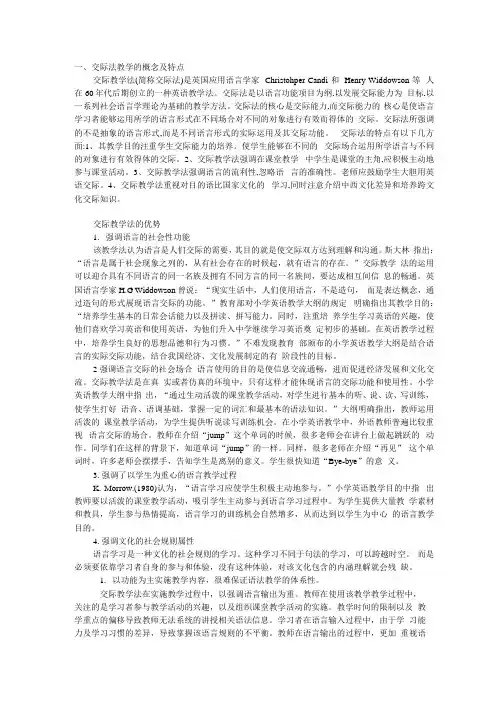
一、交际法教学的概念及特点交际教学法(简称交际法)是英国应用语言学家Christohper Candi 和Henry Widdowson 等人在60年代后期创立的一种英语教学法。
交际法是以语言功能项目为纲,以发展交际能力为目标,以一系列社会语言学理论为基础的教学方法。
交际法的核心是交际能力,而交际能力的核心是使语言学习者能够运用所学的语言形式在不同场合对不同的对象进行有效而得体的交际。
交际法所强调的不是抽象的语言形式,而是不同语言形式的实际运用及其交际功能。
交际法的特点有以下几方面:1、其教学目的注重学生交际能力的培养。
使学生能够在不同的交际场合运用所学语言与不同的对象进行有效得体的交际。
2、交际教学法强调在课堂教学中学生是课堂的主角,应积极主动地参与课堂活动。
3、交际教学法强调语言的流利性,忽略语言的准确性。
老师应鼓励学生大胆用英语交际。
4、交际教学法重视对目的语比国家文化的学习,同时注意介绍中西文化差异和培养跨文化交际知识。
交际教学法的优势1.强调语言的社会性功能该教学法认为语言是人们交际的需要,其目的就是使交际双方达到理解和沟通。
斯大林指出:“语言是属于社会现象之列的,从有社会存在的时候起,就有语言的存在。
”交际教学法的运用可以迎合具有不同语言的同一名族及拥有不同方言的同一名族间,要达成相互间信息的畅通。
英国语言学家H.G Widdowson曾说:“现实生活中,人们使用语言,不是造句,而是表达概念,通过造句的形式展现语言交际的功能。
”教育部对小学英语教学大纲的规定明确指出其教学目的:“培养学生基本的日常会话能力以及拼读、拼写能力。
同时,注重培养学生学习英语的兴趣,使他们喜欢学习英语和使用英语,为他们升入中学继续学习英语奠定初步的基础。
在英语教学过程中,培养学生良好的思想品德和行为习惯。
”不难发现教育部颁布的小学英语教学大纲是结合语言的实际交际功能,结合我国经济、文化发展制定的有阶段性的目标。
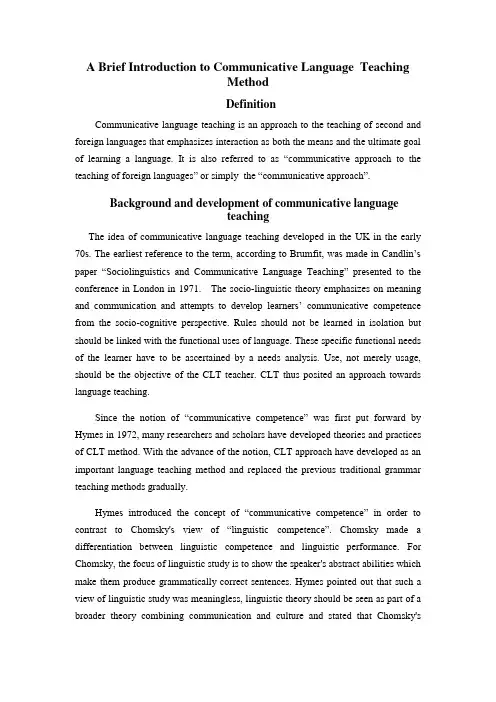
A Brief Introduction to Communicative Language TeachingMethodDefinitionCommunicative language teaching is an approach to the teaching of second and foreign languages that emphasizes interaction as both the means and the ultimate goal of learning a language. It is also referred to as ―communicative approach to the teaching of foreign languages‖ or simply the ―communicative approach‖.Background and development of communicative language teaching The idea of communicative language teaching developed in the UK in the early70s. The earliest reference to the term, according to Brumfit, was made in Candlin’spaper ―Sociolinguistics and Communicative Language Teaching‖ presented to theconference in London in 1971. The socio-linguistic theory emphasizes onmeaning and communication and attempts to develop learners’communicative competencefrom the socio-cognitive perspective. Rules should not be learned in isolation but should be linked with the functional usesof language. These specific functional needs of the learner have to be ascertained by aneeds analysis. Use, not merely usage, should be the objective of the CLTteacher. CLT thus posited an approach towards language teaching.Since the notion of ―communicative competence‖wasfirst put forward by Hymes in 1972, many researchers and scholars havedeveloped theoriesand practices of CLT method. With theadvance of the notion, CLT approach have developed as an important language teachingmethod and replaced the previous traditional grammar teaching methods gradually.Hymes introduced the concept of ―communicative competence‖ in order to contrast toChomsky's view of ―linguisticcompetence‖. Chomsky made a differentiation betweenlinguistic competence and linguistic performance.For Chomsky, the focus oflinguistic study is to show the speaker's abstract abilities which make them producegrammatically correct sentences. Hymes pointed out that such a view of linguistic study wasmeaningless, linguistic theory should be seen as part of a broader theory combiningcommunication and culture and stated that Chomsky'scategory of performance, which included just psychological restraints on performance and ignored all factors of socialinteraction.In Hymes' opinion, a person who acquires communicative competence acquires notonly the grammatical knowledge but also the ability to use the language as for if something isformally possible; if something is practical by the way of implementation available; ifsomething is appropriate in relation to a context that it is used; if something is done in fact.The main characteristics and principles of CLTCLT derives its essential characteristics from the fact that at every stage-the setting oflearning objectives, the development of learning contents, the elaboration and implementationof classroom activities, the judgment of learners' progress, and the definition of a syllabus—itfocuses on language as a medium of communication (Little, 1991). CLT has manycharacteristics which can be summarized as follows:(1) Language teaching should pay more attention on meaning rather thanform;(Johnson,1982; Bnunfit, 1981);(2)Fluencyshould be emphasized beforeaccuracy (Finocchiaro&Bnmifit, 1981);(3)After the learners have achieved fluency, the accuracy ofexpression should become the focus of teaching (Savignon, 1983);(4)The sequence of language presentation should be based on the semanticconsiderations and the analysis of learners' needs rather than according to linguistic structure(Munby,1978);(5) Since learning a language means learning to do things by way of the language,language teaching should be on the basis of activities (Littlewood, 1981);(6)CLT focus systematic on functional as well as structural views of language, integrating these views into a more fully communicative idea (Littlewood, 1981);(7)Since authentic communication needs a real exchange of information, classroom communication should have information gap (Prabhu,1987);(8)Since language use is the main goal of language teaching, learners should be exposedto real language in use on the basis of real materials (Allright,1981);(9)Learners should be encouraged to improve the strategies to communicate meaning inreal situations which may be above their present level of language proficiency (Canale,1983);(10) Learners should become subtle to the notion of suitableness in communication (Canale,1983).Richands and Rogers stated that ―there are some principles to be taken into considerationin practice: the task principle, the communication principle and theprinciple.‖ The followings are seven principles of CLT which s ummarized by Berns in 1990.(1) Language teaching is on the basis of the notion that language is used forcommunication. That is, language is viewed as a social tool which speakers use to makemeaning and communicate with someone about something for some purpose.(2) Diversity is recognized and accepted as a part of language development.(3) A learner's competence is viewed in relative, not in absolute aspects.(4) Over one variety of a language is recognized as a feasible sample for languageteaching and learning.(5) No single methodology or regular set of techniques is provided.(6) Language use is considered as serving textual, ideational, and interpersonal functionsand is bound up with the development of learners' competence.(7)It is fundamental that learners should be at devoted to doing things with language—that is, they use language for a lot of purposes in all periods of learning.Classroom ProceduresSano, et al (1984) argues that communicative language teaching should meet the local needs and the methodology of FL teaching should vary significantly according to the environments in which teachers find themselves working. Based on the teaching aim at the secondary schools in Japan "linguistic competence plus an ability to use the language appropriately", teachers from the communicative Teaching Society chose a method of teaching English which would be effective and appropriate in Japan and which was different from that of CLT developing in Europe at about the same time.Their procedures is :1) Warm-up.This offers learners interesting language activities to relax them and to let them use English creatively. Establishing a non-threatening environment is given prime importance here.2) Introduction of new grammatical items. This is usually carried out through conversion between the teacher and learners concerning objects or incidents familiar to them.... After eliciting appropriate responses for learners, the teacher explains the meaning of the items briefly in Japanese.3)Practice.This is generally carried out either by stimulating learners’ intellectual curiosity or by appealing to their emotional value judgments. Self—expression, activities, though sometimes quite limited in scope, are incorporated even at the earliest stage. C are is also taken to make learning and Production ―deep‖ .4) Reading the text.This includes listening to the tape of a ―gist‖explanation of the content, as well reading the text both silently and aloud.5) Communicative practice. This requires not only mastery of the target item, but also creative use of the knowledge of language so far acquired. It can be totally oral, but quite often involves some writing.There is another procedure designed by Terry Moston and Malcolm Sexton which is a systematic collection of exercise-types. They are:1) Organizing Information. Exercises in this phase focus on ways of encouraging learners to check their basic understanding of a variety of texts in a controlled way, using a range of matching and multiple choice exercises linked to various written, pictorial and heard stimuli.2) Implanting Skills. Here exercises introduce controlled simulations, designed to exploitthevariety of social meanings contained with particular grammatical structures in different situations. Once again the exercises make use of a range of stimuli.3) Developing Skills. Exercises in this phase are intended to enable the learner to make productive use of his language, but still within controlled situations.Gradually,however, the exercises encourage manage transfer to those situations and areas of interest which are personal to the hearer.4) Using Skills.In this open-ended phase, exercises concentrate on language charts and discourse plans to stimulate the production of extended spoken and written communication.Evaluation(1)Advantages of CLTCommunication—According to AbilityWhether CLT should be considered an approach or a methodology is a more abstract debate and here I want to deal with its more practical aspects. In fact, it is those very elements, and the name itself, which have been used to challenge the future relevance of CLT. Firstly, the label implies a focus on communication and some might argue that this method can't be employed genuinely with low levels as there is no authentic communication, due to a limited vocabulary and restricted range of functions. Initially, many of a learner's utterances are very formulaic. As an aside, consider just what percentage of our own English expressions are unique, and how often we rely on a set phrase; just because it is delivered unselfconsciously and with natural intonation does not make it original. The aim is that the length and complexity of exchanges, and confident delivery, will grow with the student's language ability.With the emphasis on communication, there is also the implication that spoken exchanges should be authentic and meaningful; detractors claim that the artificial nature of classroom–based (i.e. teacher - created) interactions makes CLT an oxymoron. Nevertheless, a proficient teacher will provide a context so that class interactions are realistic and meaningful but with the support needed to assist students to generate the target language. We need to consider that producing language is a skill and when we learn a skill we practise in improvised settings. For example, before a nurse gives a real injection, they have punctured many a piece of fruit to hone their technique.Accuracy as Well as InfluencyThis focus on accuracy versus fluency is one of the issues not often considered in a discussion of CLT. The teacher decides to pay attention to one or other end of this band, depending on the type of lesson, or the stage of a particular lesson, and accuracy is their choice if they want to deal with students getting things right, take an opportunity for correction, or gauge the success of their teaching, for example. Freerspeaking involves more choice, therefore more ambiguity, and less teacher intervention. While CLT implies the lessons are more student-centered, this does not mean they are un-structured. The teacher does have a very important role in the process, and that is setting up activities so that communication actually happens. There is a lot of preparation; accuracy practice is the bridge to a fluency activity. By implication, CLT involves equipping students with vocabulary, structures and functions, as well as strategies, to enable them to interact successfully.Promoting LearningThis returns us to the consideration of who we are teaching, and why. Are our students aiming to learn or acquire English? Do they need to know lexical items and linguistic rules as a means of passing an exam, or do they want to be able to interact in English? For those inclined to maintain the dichotomy between learning and acquisition, and who argue that our primary focus is learners, CLT still has relevance. It is timely to review an early definition of CLT. According to Richards and Rodgers, in Guangwei Hu, CLT is basically about promoting learning.(2)DisadvantagesThe style also is potential limited to certain types of student. For instance, it might benefit field-independent students rather than field- dependent students, extroverts rather than introverts, and less academic students rather than academic students. The CLT is not appropriate to students with an interest in language structure or a desire for personal liberation.ConclusionCLT is an innovation in language teaching. It emerged as a new teaching method in Britain in the 1970s and became popular since than. It views language as a vehicle for communication. It recognizes as its aim the teaching of communicative competence, which includes grammatical competence, sociolinguistic competence, discourse competence and strategic competence. Communicative activities play an important role in developing communicative competence and are an important part in communicative classrooms. In communicative classrooms, the teacher's role is facilitator and co-communicator while students become communicators. The communicative teaching procedure has no fixed format and can vary with local needs. Teachers can use CLT flexibly according to their teaching context. With theknowledge of CLT and a better understanding of CLT principles, teachers are likely to succeed in education.Reference(1)Allright, R 1981. Language leaning through communicative practice. In K. Johnson.& K. Morrow (Eds.), Communication in the Classroom. London: Longman.(2)Berns, Margie S. 1990. Contexts of Competence: Social andCultural Consideration inCommunicative Language Teaching. New York: Plenum Press.(3)Hymes, D. 1972. On Communicative Competence. [M]. Harmondsworth: Penguin.(4)Hymes, D. 1979. On Communicative Competence: The Communicative Approach to Language Teaching. Eds. C. J. Bnimfit&K Johnson. Oxfor3: Oxford University Press(5)Cai, Kun(蔡坤). 2002.交际教学法的理论、实践与思考,[J] 广西师范大学学报(1)。

clt教学法
教学反思学习理念(CLT)是:课程设计着最熟悉教学资源,最有效支持学习成果,
优化学习环境,为学习者提供有益的学习活动来支持他们的学习。
在CLT课堂上,教师以
学生为核心,教师将更多精力放在生动、精彩和有趣的课堂活动上,以此有效地激发学习
热情,并使学生获得最大的学习效果。
CLT课堂依赖各种活动,以实现课堂内容。
教师的重点是在掌握课程内容的基础上,
引入更多的活动以支撑主题,以激发学生内在的求知欲望。
CLT课堂的活动类型很多,可
以根据不同的课堂内容,灵活的选取适当的活动形式,如向不同的组分发问、小组合作等等。
这些活动让学生更深入的参与到课程当中,并有趣味地学习课程中的新知识。
CLT模式也强调了学习者本位,CLT教师要分析学生在学习上的需求,合理选择学习
内容和设计教学活动。
学生可以以自身特点和学习习惯为把握争取更好的学习成果,并从
中得到乐趣和满足感。
教师应灵活机动,让学生能够证明自己的想法,形成能够让他们更
好的学习的学习态度和意识。
通过采用CLT模式,学生可以获得课堂学习的最大效果。
作为一种跨学科的教学方式,CLT模式更注重学习活动和学习过程,让学生更丰富的参与其中,尤其是一些跨学科知识,真正把学习者的理念贯穿于课堂学习中,实现学习最大效果。
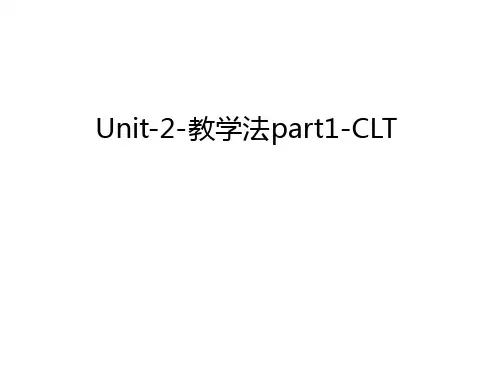
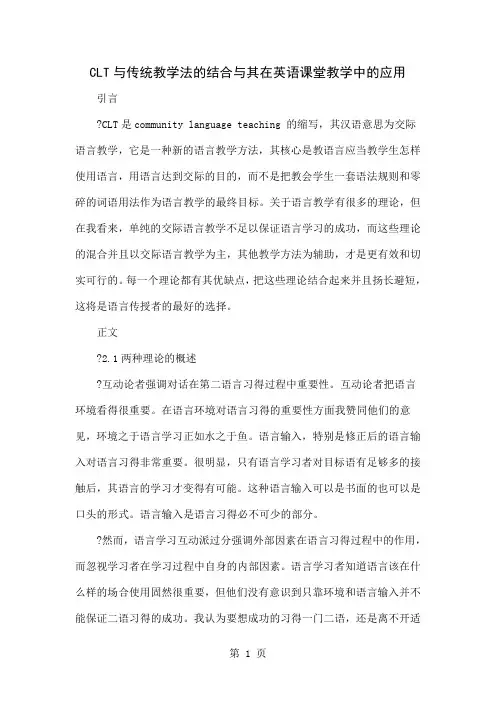
CLT与传统教学法的结合与其在英语课堂教学中的应用引言?CLT是community language teaching 的缩写,其汉语意思为交际语言教学,它是一种新的语言教学方法,其核心是教语言应当教学生怎样使用语言,用语言达到交际的目的,而不是把教会学生一套语法规则和零碎的词语用法作为语言教学的最终目标。
关于语言教学有很多的理论,但在我看来,单纯的交际语言教学不足以保证语言学习的成功,而这些理论的混合并且以交际语言教学为主,其他教学方法为辅助,才是更有效和切实可行的。
每一个理论都有其优缺点,把这些理论结合起来并且扬长避短,这将是语言传授者的最好的选择。
正文?2.1两种理论的概述?互动论者强调对话在第二语言习得过程中重要性。
互动论者把语言环境看得很重要。
在语言环境对语言习得的重要性方面我赞同他们的意见,环境之于语言学习正如水之于鱼。
语言输入,特别是修正后的语言输入对语言习得非常重要。
很明显,只有语言学习者对目标语有足够多的接触后,其语言的学习才变得有可能。
这种语言输入可以是书面的也可以是口头的形式。
语言输入是语言习得必不可少的部分。
?然而,语言学习互动派过分强调外部因素在语言习得过程中的作用,而忽视学习者在学习过程中自身的内部因素。
语言学习者知道语言该在什么样的场合使用固然很重要,但他们没有意识到只靠环境和语言输入并不能保证二语习得的成功。
我认为要想成功的习得一门二语,还是离不开适当的模仿和练习,正如人类的其他行为一样,语言的习得也是一个习惯的形成过程。
学习外语的人都知道,我们在学习一条语法规则的时候都会先模仿其句子结构,模仿和练习可以有效避免语言学习者一开始就犯错误。
对这些理论的分析让我认识到CLT和传统教学方法的结合对教师来说才是更有用的。
?2.2混合理论在课堂上的应用?如果我是一名英语教师,我将会这样安排我的课堂教学,首先我要变更现有的学生成绩评定制度,之前的学生成绩评估只是靠试卷评估,填空,选择,作文等传统方式,这些方式都是要求同学们用手写,通过反复的练习和模仿同学们可以很好的掌握某一个语法点。
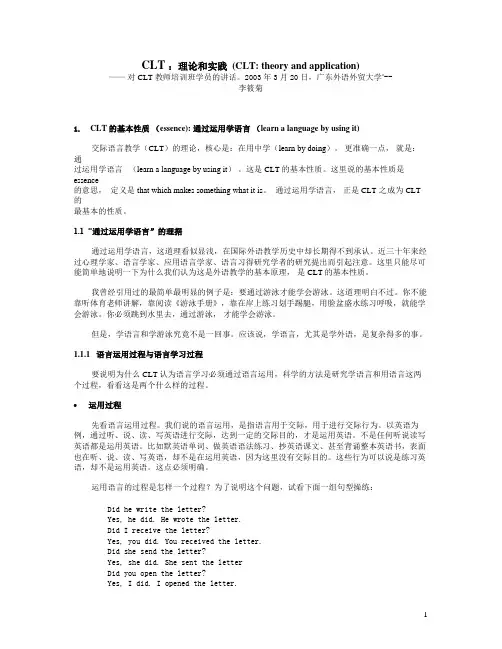
CLT :理论和实践 (CLT: theory and application)——对CLT教师培训班学员的讲话。
2003年3月20日,广东外语外贸大学*--李筱菊1. CLT的基本性质(essence): 通过运用学语言(learn a language by using it)交际语言教学(CLT)的理论,核心是:在用中学(learn by doing)。
更准确一点,就是:通过运用学语言(learn a language by using it)。
这是CLT的基本性质。
这里说的基本性质是essence的意思,定义是 that which makes something what it is。
通过运用学语言,正是CLT 之成为CLT 的最基本的性质。
1.1 “通过运用学语言”的理据通过运用学语言,这道理看似显浅,在国际外语教学历史中却长期得不到承认。
近三十年来经过心理学家、语言学家、应用语言学家、语言习得研究学者的研究提出而引起注意。
这里只能尽可能简单地说明一下为什么我们认为这是外语教学的基本原理,是CLT的基本性质。
我曾经引用过的最简单最明显的例子是:要通过游泳才能学会游泳。
这道理明白不过。
你不能靠听体育老师讲解,靠阅读《游泳手册》,靠在岸上练习划手踢腿,用脸盆盛水练习呼吸,就能学会游泳。
你必须跳到水里去,通过游泳,才能学会游泳。
但是,学语言和学游泳究竟不是一回事。
应该说,学语言,尤其是学外语,是复杂得多的事。
1.1.1 语言运用过程与语言学习过程要说明为什么CLT认为语言学习必须通过语言运用,科学的方法是研究学语言和用语言这两个过程,看看这是两个什么样的过程。
运用过程先看语言运用过程。
我们说的语言运用,是指语言用于交际,用于进行交际行为。
以英语为例,通过听、说、读、写英语进行交际,达到一定的交际目的,才是运用英语。
不是任何听说读写英语都是运用英语。
比如默英语单词、做英语语法练习、抄英语课文、甚至背诵整本英语书,表面也在听、说、读、写英语,却不是在运用英语,因为这里没有交际目的。
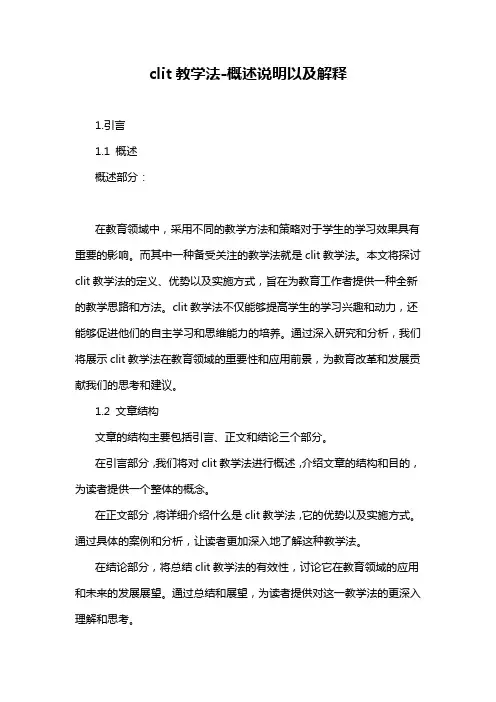
clit教学法-概述说明以及解释1.引言1.1 概述概述部分:在教育领域中,采用不同的教学方法和策略对于学生的学习效果具有重要的影响。
而其中一种备受关注的教学法就是clit教学法。
本文将探讨clit教学法的定义、优势以及实施方式,旨在为教育工作者提供一种全新的教学思路和方法。
clit教学法不仅能够提高学生的学习兴趣和动力,还能够促进他们的自主学习和思维能力的培养。
通过深入研究和分析,我们将展示clit教学法在教育领域的重要性和应用前景,为教育改革和发展贡献我们的思考和建议。
1.2 文章结构文章的结构主要包括引言、正文和结论三个部分。
在引言部分,我们将对clit教学法进行概述,介绍文章的结构和目的,为读者提供一个整体的概念。
在正文部分,将详细介绍什么是clit教学法,它的优势以及实施方式。
通过具体的案例和分析,让读者更加深入地了解这种教学法。
在结论部分,将总结clit教学法的有效性,讨论它在教育领域的应用和未来的发展展望。
通过总结和展望,为读者提供对这一教学法的更深入理解和思考。
1.3 目的本文的目的在于介绍和探讨clit教学法的概念、优势以及实施方式,旨在帮助读者了解这种教学方法的特点和优势所在。
通过详细分析和讨论,我们希望能够引起教育工作者对于clit教学法的关注和思考,促进其在教育领域的应用和推广。
同时,我们也希望能够为教育改革和教学方法创新提供一些新的思路和启示,从而提高教育质量,促进学生学习效果的提升。
通过本文的阐述,我们希望能够激发教师和教育管理者对于教学方法改革的热情,推动教育事业的进步和发展。
2.正文2.1 什么是clit教学法clit教学法是一种注重学生主动参与和实践的教学方法。
它强调学生在学习过程中的自主性和合作性,让学生通过实际操作和实践来掌握知识和技能。
在clit教学法中,教师不再是传统意义上的知识传授者,而是学生学习的引导者和组织者。
教师通过设计启发性和挑战性的学习任务,激发学生的思维和创造力,引导学生自主学习和合作学习。
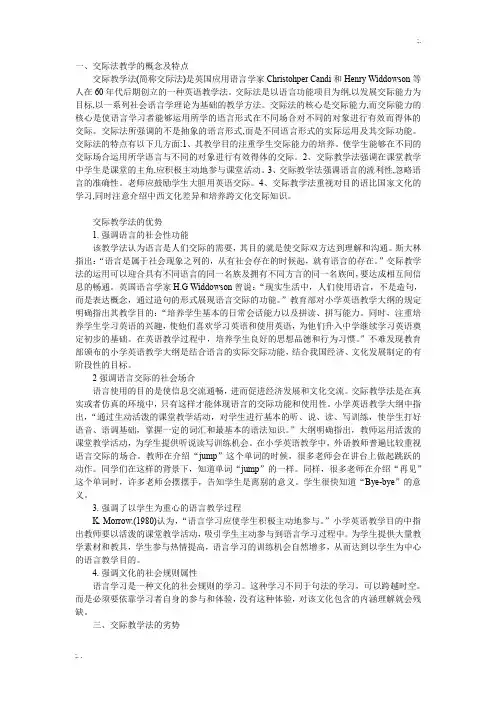
一、交际法教学的概念及特点交际教学法(简称交际法)是英国应用语言学家Christohper Candi和Henry Widdowson等人在60年代后期创立的一种英语教学法。
交际法是以语言功能项目为纲,以发展交际能力为目标,以一系列社会语言学理论为基础的教学方法。
交际法的核心是交际能力,而交际能力的核心是使语言学习者能够运用所学的语言形式在不同场合对不同的对象进行有效而得体的交际。
交际法所强调的不是抽象的语言形式,而是不同语言形式的实际运用及其交际功能。
交际法的特点有以下几方面:1、其教学目的注重学生交际能力的培养。
使学生能够在不同的交际场合运用所学语言与不同的对象进行有效得体的交际。
2、交际教学法强调在课堂教学中学生是课堂的主角,应积极主动地参与课堂活动。
3、交际教学法强调语言的流利性,忽略语言的准确性。
老师应鼓励学生大胆用英语交际。
4、交际教学法重视对目的语比国家文化的学习,同时注意介绍中西文化差异和培养跨文化交际知识。
交际教学法的优势1. 强调语言的社会性功能该教学法认为语言是人们交际的需要,其目的就是使交际双方达到理解和沟通。
斯大林指出:“语言是属于社会现象之列的,从有社会存在的时候起,就有语言的存在。
”交际教学法的运用可以迎合具有不同语言的同一名族及拥有不同方言的同一名族间,要达成相互间信息的畅通。
英国语言学家H.G Widdowson曾说:“现实生活中,人们使用语言,不是造句,而是表达概念,通过造句的形式展现语言交际的功能。
”教育部对小学英语教学大纲的规定明确指出其教学目的:“培养学生基本的日常会话能力以及拼读、拼写能力。
同时,注重培养学生学习英语的兴趣,使他们喜欢学习英语和使用英语,为他们升入中学继续学习英语奠定初步的基础。
在英语教学过程中,培养学生良好的思想品德和行为习惯。
”不难发现教育部颁布的小学英语教学大纲是结合语言的实际交际功能,结合我国经济、文化发展制定的有阶段性的目标。
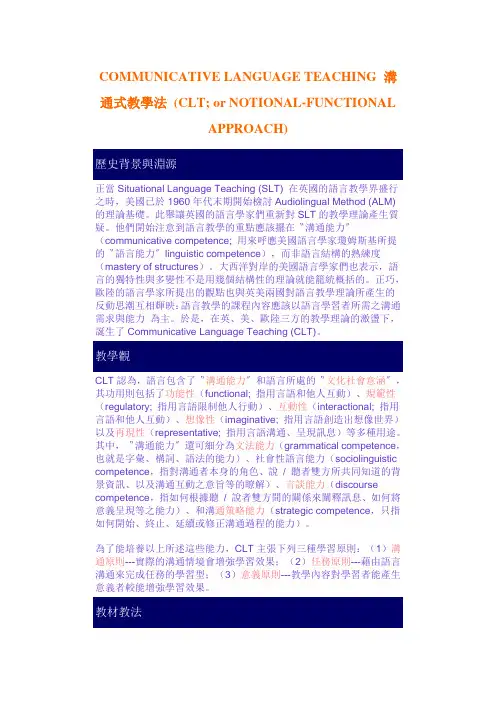
COMMUNICATIVE LANGUAGE TEACHING 溝通式教學法(CLT; or NOTIONAL-FUNCTIONALAPPROACH)正當Situational Language Teaching (SLT) 在英國的語言教學界盛行之時,美國已於1960年代末期開始檢討Audiolingual Method (ALM) 的理論基礎。
此舉讓英國的語言學家們重新對SLT的教學理論產生質疑。
他們開始注意到語言教學的重點應該擺在〝溝通能力〞(communicative competence; 用來呼應美國語言學家瓊姆斯基所提的〝語言能力〞linguistic competence),而非語言結構的熟練度(mastery of structures)。
大西洋對岸的美國語言學家們也表示,語言的獨特性與多變性不是用幾個結構性的理論就能籠統概括的。
正巧,歐陸的語言學家所提出的觀點也與英美兩國對語言教學理論所產生的反動思潮互相輝映:語言教學的課程內容應該以語言學習者所需之溝通需求與能力為主。
於是,在英、美、歐陸三方的教學理論的激盪下,誕生了Communicative Language Teaching (CLT)。
CLT認為,語言包含了〝溝通能力〞和語言所處的〝文化社會意涵〞,其功用則包括了功能性(functional; 指用言語和他人互動)、規範性(regulatory; 指用言語限制他人行動)、互動性(interactional; 指用言語和他人互動)、想像性(imaginative; 指用言語創造出想像世界)以及再現性(representative; 指用言語溝通、呈現訊息)等多種用途。
其中,〝溝通能力〞還可細分為文法能力(grammatical competence,也就是字彙、構詞、語法的能力)、社會性語言能力(sociolinguistic competence,指對溝通者本身的角色、說/ 聽者雙方所共同知道的背景資訊、以及溝通互動之意旨等的瞭解)、言談能力(discourse competence,指如何根據聽/ 說者雙方間的關係來闡釋訊息、如何將意義呈現等之能力)、和溝通策略能力(strategic competence,只指如何開始、終止、延續或修正溝通過程的能力)。
CLT教学法在中学英语教学中的应用现状及改进策略一、CLT交际语言教学概述CLT是外语教学的一种方法,它强调“生本”教学理念,主要是以话语作为教学的基本单位,将综合训练作为主要的巩固形式,要求学生在教学实践和日常生活中运用英语完成交际任务,以此提高学生思维能力、人际交往能力以及创造力等英语的综合使用能力。
教师在实施过程中由课堂控制者成功转化为知识的引导者、辅导者,注重培养学生的语言能力、交际策略等实际交际能力,从而颠覆了传统教学法,提高了学生学习效率以及教师教学水平。
二、CLT在初中英语教学中改革的优势CLT教学法在初中英语教学中注重“以学生为中心”,教学过程中始终突出学生的主体地位,课堂上强调教学互动,不但培养学生学习能力,还提高了指挥协调能力、表达能力、综合能力。
课堂上教师营造外语情景,让学生在一种身临其境的语言氛围中学习和使用目标语进行交流,锻炼了学生的语言应用能力,又培养了学生的创造性思维和创新能力,让学生在潜移默化中学到了活生生的英语。
CLT教学法的应用能够提高学生的整体素质,使学生的身心得以全面的发展。
学生通过听、说、读、写等方面的语言实践活动去发展英语语言能力,培养良好的心理品质以及以交际能力为核心的英语语言运用素质。
三、CLT在初中英语教学改革中应用现状与问题CLT是一套实用的、富有生命力的、与时俱进的教学方法体系,尤其是在培养学生使用语言、提高交际能力方面发挥着举足轻重的作用。
但在实际教学过程中,受制于以教材为核心的前提,英语课堂教学依然表现为以教师、测试为中心,语言交际为辅的特点,CLT教学法不能有效地得以实施。
1.CLT实施大背景因素。
由于中国幅员辽阔,教育背景存在着相当大的差异――城市学校与农村学校之间,以及重点学校与普通学校之间在资金、教师质量、硬件设施、学生选择及资源方面的巨大差距。
不同学校在教学改革中的资金投入存在很大不同,教师整体的素质参差不齐以及各校对CLT法的认识程度不同,导致CLT教学法实施效果存在差异,最终半途而废。
交际语言教学(CLT)在小学英语教学中的应用摘要:作为一种将语言视为沟通交流媒介的教学方法,交际语言教学(CLT)在英语教学中具有较强的实用性和比较优势。
交际语言教学法强调培养学习者的交际能力。
小学英语教师应该重视交际语言教学在课堂中的应用。
本文在简述CLT教学方式定义的基础上,为小学实际课堂运用提供一定的参考和依据。
关键词:交际语言教学(CLT)交际能力小学英语课堂应用前言:CLT于20世纪70年代引入国内。
然而,CLT直到最近几年才被采用(Hu,2013)。
由于应试教育的影响, 我国以往的英语教学多是以培养学生语言知识为主, 并且主要由教师掌控教学过程,学生大多数情况是被动接受知识灌输。
许多学校仍然在英语课堂上使用传统的教学方法,基于英语语法讲解和考试目的。
英语课中教学目标主要围绕英语语言本身展开而忽视了交际能力的培养, 英语口语教学长期处于被忽略的地位,因此提高学生英语口语交际能力势在必行。
交际语言教育的定义交际语言教学是一种有效的学习方法。
所指的交际是真实、有意义的和有任务的交际。
CLT在帮助学生在不同环境中使用该语言方面发挥着重要作用。
教师要为学生提供相互交流的机会,让学生在语言学习中实现自己的目标。
CLT的定义是,任何教学实践都可以帮助学生发展他们的交际能力(Brown,2001)。
CLT是一种很好的方法应用在第二语言和外语的学习中, CLT一定是与沟通活动有关,例如,一起解决问题并且进行小组合作(Thombury,1996)。
在CLT课程中,老师会给学生一个情境,他们需要与我们的现实生活联系起来,并与他人进行交谈。
一、创设英语课堂教学交际环境在小学的英语教学阶段,其教学目标不仅仅是传授英语学习的基础知识,还要通过有效的交流互动来加强其实际的口语运用能力激发学生的英语兴趣,而实现这一目标的有效途径就是要在交际教学法的指导下创设课堂教学交际环境和氛围。
首先为了学生更好更快的融入英语环境,教室布置都是经过深思熟虑的,墙上贴满了一排按顺序排列的字母,每个单元所有新学的单词,英语颜色数字海报,英语日期天气表。
一、交际法教学的概念及特点之杨若古兰创作交际教学法(简称交际法)是英国利用说话学家Christohper Candi和Henry Widdowson等人在60年代后期创立的一种英语教学法.交际法是以说话功能项目为纲,以发展交际能力为目标,以一系列社会说话学理论为基础的教学方法.交际法的核心是交际能力,而交际能力的核心是使说话进修者能够应用所学的说话方式在分歧场合对分歧的对象进行无效而得体的交际.交际法所强调的不是抽象的说话方式,而是分歧说话方式的实际应用及其交际功能.交际法的特点有以下几方面:1、其教学目的重视先生交际能力的培养.使先生能够在分歧的交际场合应用所学说话与分歧的对象进行无效得体的交际.2、交际教学法强调在课堂教学中先生是课堂的配角,应积极自动地介入课堂活动.3、交际教学法强调说话的流利性,忽略说话的精确性.老师应鼓励先生大胆用英语交际.4、交际教学法看重对目的语比国家文明的进修,同时留意介绍中西文明差别和培养跨文明交际常识.交际教学法的上风1. 强调说话的社会性功能该教学法认为说话是人们交际的须要,其目的就是使交际双方达到理解和沟通.斯大林指出:“说话是属于社会景象之列的,从有社会存在的时候起,就有说话的存在.” Widdowson曾说:“理想生活中,人们使用说话,不是造句,而是表达概念,通过造句的方式揭示说话交际的功能.”教育部对小学英语教学大纲的规定明确指出其教学目的:“培养先生基本的日常会话能力和拼读、拼写能力.同时,重视培养先生进修英语的爱好,使他们爱好进修英语和使用英语,为他们升入中学继续进修英语奠定初步的基础.在英语教学过程中,培养先生良好的思想品德和行为习气.”不难发现教育部公布的小学英语教学大纲是结合说话的实际交际功能,结合我国经济、文明发展拟定的有阶段性的目标.2强调说话交际的社会场合说话使用的目的是使信息交流通畅,进而促进经济发展和文明交流.交际教学法是在真实或者仿真的环境中,只要如许才干体现说话的交际功能和使用性.小学英语教学大纲中指出,“通过生动活泼的课堂教学活动,对先生进行基本的听、说、读、写练习,使先生打好语音、腔调基础,把握必定的词汇和最基本的语法常识.”大纲明确指出,教师应用活泼的课堂教学活动,为先生提供听说读写练习机会.在小学英语教学中,外语教师普遍比较看重说话交际的场合.教师在介绍“jump”这个单词的时候,很多老师会在讲台上做起跳跃的动作.同学们在如许的布景下,晓得单词“jump”的一样.同样,很多老师在介绍“再会”这个单词时,很多老师会摆摆手,告知先生是离此外意义.先生很快晓得“Bye-bye”的意义.3. 强调了以先生为重心的语身教学过程K. Morrow.(1980)认为,“说话进修应使先生积极自动地介入.”小学英语教学目的中指出教师要以活泼的课堂教学活动,吸引先生自动介入到说话进修过程中.为先生提供大量教学素材和教具,先生介入热情提高,说话进修的练习机会天然增多,从而达到以先生为中间的语身教学目的.4. 强调文明的社会规则属性说话进修是一种文明的社会规则的进修.这类进修分歧于句法的进修,可以跨越时空.而是必必要依附进修者本身的介入和体验,没有这类体验,对该文明包含的内涵理解就会残破.三、交际教学法的劣势1. 以功能为主实施教学内容,很难包管语法教学的体系性.交际教学法在实施教学过程中,以强调说话输出为重.教师在使用该教学教学过程中,关注的是进修者介入教学活动的爱好,和组织课堂教学活动的实施.教学时间的限制和教学重点的偏移导致教师没法零碎的讲授相干语法信息.进修者在说话输入过程中,因为进修能力及进修习气的差别,导致把握该说话规则的不服衡.教师在说话输出的过程中,更加看重说话输出的连贯性及先生对说话的反应,也不克不及及时的为先生指出说话活动中的语法重难点.同时,进修者在说话练习过程中,因为语法的单薄,没法将信息连贯的描述出来,只是简单句型和单词的反复.难保说话口语水平的真正提高.更次要的是,在交际法深入教学以后,很多教师发现,先生似乎离开了哑吧英语的情况,敢于简单话语开口,但对其进行读写练习时,发现,绝大部分先生的读写能力极度欠缺,寻其缘由,是因为在课堂教学活动中,因为无限的课堂教学时间内,把大量的时间放在先生开口说话活动中去,教师对先生语法指点缺乏形成.2. 交际教学法教学评估困难.交际教学法指点的课堂教学活动是线性及过程性的.督导看到和听到的是先生介入说话活动的兴趣和教师组织课堂活动的能力.但因为说话交际能力不是一朝一夕的功夫,在交际法使用初期,因为进修者固有进修习气的主导感化,会使得她们对此类教学方法的不适应,形成评估的不客观性.如此同时,交际教学法实施的教学过程,进修者的说话感知能力是不竭调整的过程,教师评估进修者进修后果是很难掌控的事情.同时,因为教师在组织教学活动主如果以提供交际机会和开口说话为教学目标,对其教学进行量化评估时,就容易出现先生能开口,却说不出成心义的信息的景象.3. 教师主导感化减弱,教材依附度降低,对教师提出更高的请求.在交际教学法实施教学过程中,教师的角色从主导者转为组织者,教师没有法子猜测在教学活动中,进修者可能出现的任何疑问.教师在课堂教学活动中,以组织者身份调和师生、先生间的回话内容,因为没法预知先生对回话内容将回向何方向延长,教师在备课过程中,将不克不及不花费更多的时间和精力筹办可能谈及的素材,帮忙先生将言语话题交流持续下去.同时,尽管教师手持教案,但教案的角色发生了根本的变更,教师不克不及再照本宣科,而是按照进修者说话交流的方向调整话语轮回.这无疑是对外语教师教学全体水平提出了更高的请求.4. 在该教学法使用初期,先生适应性差.交际教学法使用初期,因为进修者本身习得二语能力无限,再加之进修者自傲缺乏,导致进修者适应交际教学法的初期,更多的是盲从和无法.教师在使用交际教学法之初,如何激发先生简单开口发言是实施好交际教学法的难点.对于初级先生,教师使用交际教学法进行语身教学,教师很可能成为“独角戏”演员.进修者成为听众.使用该教学法的教师若没能及时调整教学步调,很可能形成教学活动介入者的片面性,进修者习气性地以停着身份介入教学活动,不克不及达成交际教学法的初衷.二、任务式教学法在教学活动中,教师该当环绕特定的交际和说话项目,设计出具体的、可操纵的任务,先生通过表达、沟通、交涉、解释、扣问等各种说话活动方式来完成任务,以达到进修和把握说话的目的.任务型教学法是接收了以往多种教学法的长处而构成的,它和其它的教学法其实不排斥.任务型教学法以任务组织教学,在任务的履行过程中,以介入、体验、互动、交流、合作的进修方式,充分发挥进修者本身的认知能力,调动他们已有的目的语资本,在实践中感知、认识、利用目的语,在“干”中学,“用”中学,体现了较为进步前辈的教学理念,是一种值得推广的无效的外语教学方法.其长处是:1. 完成多种多样的任务活动,有助于激发先生的进修爱好.2. 在完成任务的过程中,将说话常识和说话技能结合起来,有助于培养先生综合的说话应用能力.3. 促进先生积极介入说话交流活动,启发想像力和创造性思维,有益于发挥先生的主体性感化.4. 在任务型教学中有大量的小组或双人活动,每个人都有本人的任务要完成,可以更好地面向全体先生进行教学.5. 活动内容涉及面广,信息量大,有助于拓宽先生的常识面.6. 在活动中进修常识,培养人际交往、思考、决策和应变能力,有益于先生的全面发展.7. 在任务型教学活动中,在教师的启发下,每个先生都有独立思考、积极介入的机会,易于坚持进修的积极性,养成良好的进修习气,在对于任务的定义上可以说是百花怒放,各有千秋.但综观各个学者对于任务的定义我们不难发现任务必须涉及情景、目标、活动、结果、意义、评价六个部分的内容.首先,任务型教学建议真实的说话情景的创设,在真实的说话情景下发生真实的交际须要;其次,任务要有必定的目标,即在规定的时间内解决实际的交际成绩;再次,任何任务都必须以活动的方式进行,它是在同伴之间通过合作、交流、探究的方式进行进修的;第四,任何任务的终极都要构成必定的产品,即结果,以检测先生们在进修中的后果;第五,任何任务都必须成心义,否则就是对说话的机械练习;最初,对于结果的评价也不容忽视,因为它是对先生劳动的肯定,同时也是一种激励.威莉斯的任务型进修框架分为三个阶段:前任务(pre-task)、任务环(task cycle)和说话聚焦(language focus).任务的类型分为六种:列举型(listing)、排序与分类(ordering and sorting)、比较型(comparing)、成绩解决型(problem solving)、交流个人经历型(sharing personalexperiences)和创外型(creative tasks).1.任务型教学的长处(1)任务型教学重视真实场景下的、以明确目标为导向的说话交际活动;它请求先生通过完成任务的进修活动来把握真实、实用和成心义的说话.先生在介入课堂活动时是带着极大的爱好和热情的,所以全部课堂是一种积极无效的进修过程.(2)它提倡以教师教学为主导、以先生的进修为主体的教学活动.在教学过程中教师不再是高高在上的权威和主宰,而是以组织者、引诱者、顾问或者同伴的身份出现,先生的进修同样成为一种满足须要、发展爱好、提高能力的过程.(3)它建议体验、实践、介入、探究、交流和合作的进修方式,先生在介入教师或教材精心设计的任务活动中认识说话,应用说话,发现成绩,找出规律,归纳常识和感受成功.2.任务型教学的缺点在目前我国大多数中小学中,特别是在广大的农村黉舍中大班额的条件下,任务型教学便明显地显示出其缺乏的地方.(1)课堂效力低,难以包管大班额课堂教学任务的完成.任务型教学以先生的进修为中间,把课堂进修的自动权交给了先生,虽然教师可以根据课堂实际情况对课堂进度进行调控,但因为目前班级的实际情况(大多数班级人数在50摆布,农村黉舍甚至更多)课堂所设计的任务或项目普通都很难在规定的时间内完成.所以常常教师采纳的做法是要末缩短任务完成的时间,要末把部分任务放到课后去完成,如许就形成课堂任务完成的质量难以包管,甚至任务的履行同样成为方式和走过场.(2)课堂的组织和任务的设计与实施过分依附教师的教学能力和教学水平,故在目前很难包管大面积的教学质量的提升.我们发现有的教师对于任务型课堂教学的模式掌控的其实不是很理想.有的教师墨守成规地完成课本上的教学步调,形成先生词汇、语法、句式等基础常识严重缺乏,影响其今后的进一步进修;而有的教师则还是因循传统的3P教学,强化词汇和说话的输入,把教材上的活动任务作为练习和弥补,如许先生的基础常识是扎实了,但又严重离开了任务型教学的初衷,把本来要还给先生的课堂又酿成了以教师为主的练兵场了.(3)课堂中先生的个体活动难以无效监督和控制,反馈效力低.任务型课堂教学的特点就是把课堂活动任务化,让先生在通过完成一系列的任务中习得说话常识.而在实际教学中当教师安插了任务并分好小组进行时却常常发现部分先生在交流中并没有使用目的语,而是应用母语进行,虽然反复强调,但后果其实不是很好.究竟初始阶段的先生用目的说话的表达能力无限,同时也对于进修英语的目的性不是很明确,他们为了能尽快完成任务而在交流中一碰到困难就立即使用母语进行也就其实不奇怪了.同时因为任务的完成须要必定的时间,所以对于先生进修和常识把握情况的反馈也就绝对较慢,形成课堂教学时间和教学进度很难掌控.。
运用clt的教案标题:运用CLT的教案教案概述:本教案旨在通过运用通信语言教学(Communicative Language Teaching,简称CLT)的方法,促进学生的语言交际能力,提高其口头表达和听力技能。
本教案适用于中学高年级,学生年龄段为13-15岁。
教学目标:1. 学生能够在真实语境中运用所学的语言进行有效的交际。
2. 学生能够使用正确的语法结构和相关词汇表达自己的观点和意见。
3. 学生能够理解并回应与主题相关的对话和提问。
4. 学生能够通过合作学习和角色扮演提高自己的听力和口头表达能力。
教学资源:1. 网络或视频资源,展示真实语境的对话和情景。
2. 板书或投影仪,用于展示重要的词汇、句型和语法结构。
教学步骤:引入(5分钟):1. 向学生介绍本节课的主题,例如"描述一个动漫人物"。
2. 播放一个与该主题相关的视频片段,引发学生兴趣。
听力理解(10分钟):1. 播放一个关于动漫人物的短片,要求学生仔细听并回答相关问题。
2. 引导学生互相讨论他们的答案以及对片段中人物的看法。
词汇与语法练习(15分钟):1. 教师呈现与主题相关的新词汇和有关描述人物的常用句型。
2. 学生进行词汇和语法练习,例如填空、选择题等,巩固学习内容。
角色扮演(20分钟):1. 将学生分成小组,每个小组选择一个动漫人物进行角色扮演。
2. 学生根据所学的词汇和句型,扮演自己选择的角色并进行对话。
3. 教师巡视各小组并给予必要的指导和反馈。
交流反馈(10分钟):1. 各小组展示他们的角色扮演表演。
2. 鼓励其他学生提问和对表演进行评价。
3. 提供积极的反馈和建议,让学生在交流中得到进一步的提高。
总结与作业(5分钟):1. 回顾本节课的学习内容和重点。
2. 布置作业,要求学生以笔记的形式写下他们对于角色扮演活动的反思和体会。
教学评估:1. 观察学生在角色扮演中的表现,评估其口头表达能力和语法运用的准确性。
一、寒暄法教学的概念及特点之五兆芳芳创作寒暄教学法(简称寒暄法)是英国应用语言学家Christohper Candi和Henry Widdowson等人在60年代前期创立的一种英语教学法.寒暄法是以语言功效项目为纲,以成长寒暄能力为目标,以一系列社会语言学理论为根本的教学办法.寒暄法的焦点是寒暄能力,而寒暄能力的焦点是使语言学习者能够运用所学的语言形式在不合场合对不合的对象进行有效而得体的寒暄.寒暄法所强调的不是抽象的语言形式,而是不合语言形式的实际运用及其寒暄功效.寒暄法的特点有以下几方面:1、其教学目的注重学生寒暄能力的培养.使学生能够在不合的寒暄场合运用所学语言与不合的对象进行有效得体的寒暄.2、寒暄教学法强调在课堂教学中学生是课堂的主角,应积极主动地介入课堂勾当.3、寒暄教学法强调语言的流利性,疏忽语言的准确性.老师应鼓动勉励学生大胆用英语寒暄.4、寒暄教学法重视对目的语比国度文化的学习,同时注意介绍中西文化差别和培养跨文化寒暄知识.寒暄教学法的优势1. 强调语言的社会性功效该教学法认为语言是人们寒暄的需要,其目的就是使寒暄双方达到理解和沟通.斯大林指出:“语言是属于社会现象之列的,从有社会存在的时候起,就有语言的存在.” Widdowson曾说:“现实生活中,人们使用语言,不是造句,而是表达概念,通过造句的形式展现语言寒暄的功效.”教育部对小学英语教学大纲的法则明确指出其教学目的:“培养学生根本的日常会话能力以及拼读、拼写能力.同时,注重培养学生学习英语的兴趣,使他们喜欢学习英语和使用英语,为他们升入中学持续学习英语奠定初步的根本.在英语教学进程中,培养学生良好的思想品德和行动习惯.”不难发明教育部颁布的小学英语教学大纲是结合语言的实际寒暄功效,结合我国经济、文化成长制定的有阶段性的目标.2强调语言寒暄的社会场合语言使用的目的是使信息交换通畅,进而促进经济成长和文化交换.寒暄教学法是在真实或仿真的情况中,只有这样才干体现语言的寒暄功效和使用性.小学英语教学大纲中指出,“通过生动活跃的课堂教学勾当,对学生进行根本的听、说、读、写训练,使学生打好语音、语调根本,掌握一定的词汇和最根本的语法知识.”大纲明确指出,教师运用活跃的课堂教学勾当,为学生提供听说读写训练机遇.在小学英语教学中,外语教师普遍比较重视语言寒暄的场合.教师在介绍“jump”这个单词的时候,良多老师会在讲台上做起跳跃的动作.同学们在这样的布景下,知道单词“jump”的一样.同样,良多老师在介绍“再见”这个单词时,许多老师会摆摆手,奉告学生是离此外意义.学生很快知道“Bye-bye”的意义.3. 强调了以学生为重心的语言教学进程K. Morrow.(1980)认为,“语言学习应使学生积极主动地介入.”小学英语教学目的中指出教师要以活跃的课堂教学勾当,吸引学生主动介入到语言学习进程中.为学生提供大量教学素材和教具,学生介入热情提高,语言学习的训练机遇自然增多,从而达到以学生为中心的语言教学目的.4. 强调文化的社会法则属性语言学习是一种文化的社会法则的学习.这种学习不合于句法的学习,可以跨越时空.而是必须要依靠学习者自身的介入和体验,没有这种体验,对该文化包含的内涵理解就会残破.三、寒暄教学法的劣势1. 以功效为主实施教学内容,很难包管语法教学的体系性.寒暄教学法在实施教学进程中,以强调语言输出为重.教师在使用该教学教学进程中,存眷的是学习者介入教学勾当的兴趣,以及组织课堂教学勾当的实施.教学时间的限制以及教学重点的偏移导致教师无法系统的讲解相关语法信息.学习者在语言输入进程中,由于学习能力及学习习惯的差别,导致掌握该语言法则的不服衡.教师在语言输出的进程中,加倍重视语言输出的连贯性及学生对语言的反响,也不克不及实时的为学生指出语言勾当中的语法重难点.同时,学习者在语言训练进程中,由于语法的单薄,无法将信息连贯的描述出来,只是复杂句型和单词的重复.难保语言口语水平的真正提高.更重要的是,在寒暄法深入教学之后,良多教师发明,学生似乎脱离了哑巴英语的状况,勇于复杂话语开口,但对其进行读写训练时,发明,绝大部分学生的读写能力极端欠缺,寻其原因,是由于在课堂教学勾当中,由于有限的课堂教学时间内,把大量的时间放在学生开口说话勾当中去,教师对学生语法指导缺乏造成.2. 寒暄教学法教学评估困难.寒暄教学法指导的课堂教学勾当是线性及进程性的.督导看到和听到的是学生介入语言勾当的兴致以及教师组织课堂勾当的能力.但由于语言寒暄能力不是一朝一夕的工夫,在寒暄法使用初期,由于学习者固有学习习惯的主导作用,会使得她们对此类教学办法的不适应,造成评估的不客不雅性.如此同时,寒暄教学法实施的教学进程,学习者的语言感知能力是不竭调整的进程,教师评估学习者学习效果是很难掌控的事情.同时,由于教师在组织教学勾当主要是以提供寒暄机遇和开口说话为教学目标,对其教学进行量化评估时,就容易出现学生能开口,却说不出有意义的信息的现象.3. 教师主导作用削弱,教材依赖度下降,对教师提出更高的要求.在寒暄教学法实施教学进程中,教师的角色从主导者转为组织者,教师没有办法预测在教学勾当中,学习者可能出现的任何疑问.教师在课堂教学勾当中,以组织者身份协调师生、学生间的回话内容,由于无法预知学生对回话内容将回向何标的目的延伸,教师在备课进程中,将不克不及不破费更多的时间和精力准备可能谈及的素材,帮忙学生将言语话题交换持续下去.同时,尽管束师手持教案,但教案的角色产生了底子的变更,教师不克不及再照本宣科,而是依照学习者语言交换的标的目的调整话语轮回.这无疑是对外语教师教学整体水平提出了更高的要求.4. 在该教学法使用初期,学生适应性差.寒暄教学法使用初期,由于学习者自身习得二语能力有限,再加上学习者自信缺乏,导致学习者适应寒暄教学法的初期,更多的是盲从和无奈.教师在使用寒暄教学法之初,如何引发学生复杂开口讲话是实施好寒暄教学法的难点.对于初级学生,教师使用寒暄教学法进行语言教学,教师极可能成为“独角戏”演员.学习者成为听众.使用该教学法的教师若没能实时调整教学步调,极可能造成教学勾当介入者的片面性,学习者习惯性地以停着身份介入教学勾当,不克不及达成寒暄教学法的初衷.二、任务式教学法在教学勾当中,教师应当围绕特定的寒暄和语言项目,设计出具体的、可操纵的任务,学生通过表达、沟通、交涉、解释、询问等各类语言勾当形式来完成任务,以达到学习和掌握语言的目的.任务型教学法是吸收了以往多种教学法的优点而形成的,它和其它的教学法其实不排斥.任务型教学法以任务组织教学,在任务的履行进程中,以介入、体验、互动、交换、协作的学习方法,充分阐扬学习者自身的认知能力,调动他们已有的目的语资源,在实践中感知、认识、应用目的语,在“干”中学,“用”中学,体现了较为先进的教学理念,是一种值得推广的有效的外语教学办法.其优点是:1. 完成多种多样的任务勾当,有助于激起学生的学习兴趣.2. 在完成任务的进程中,将语言知识和语言技巧结合起来,有助于培养学生综合的语言运用能力.3. 促进学生积极介入语言交换勾当,启发想像力和创造性思维,有利于阐扬学生的主体性作用.4. 在任务型教学中有大量的小组或双人勾当,每团体都有自己的任务要完成,可以更好地面向全体学生进行教学.5. 勾当内容涉及面广,信息量大,有助于拓宽学生的知识面.6. 在勾当中学习知识,培养人际来往、思考、决策和应变能力,有利于学生的全面成长.7. 在任务型教学勾当中,在教师的启发下,每个学生都有独立思考、积极介入的机遇,易于保持学习的积极性,养成良好的学习习惯,在对于任务的定义上可以说是百花怒放,各有所长.但综不雅各个学者对于任务的定义我们不难发明任务必须涉及情景、目标、勾当、结果、意义、评价六个部分的内容.首先,任务型教学建议真实的语言情景的创设,在真实的语言情景下产生真实的寒暄需要;其次,任务要有一定的目标,即在法则的时间内解决实际的寒暄问题;再次,任何任务都必须以勾当的形式进行,它是在同伴之间通过协作、交换、探究的方法进行学习的;第四,任何任务的最终都要形成一定的产品,即结果,以检测学生们在学习中的效果;第五,任何任务都必须有意义,不然就是对语言的机械训练;最后,对于结果的评价也不容轻忽,因为它是对学生劳动的肯定,同时也是一种鼓励.威莉斯的任务型学习框架分为三个阶段:前任务(pre-task)、任务环(task cycle)和语言聚焦(language focus).任务的类型分为六种:列举型(listing)、排序与分类(ordering and sorting)、比较型(comparing)、问题解决型(problem solving)、交换团体经历型(sharing personal experiences)和创造型(creative tasks).1.任务型教学的优点(1)任务型教学注重真实场景下的、以明确目标为导向的语言寒暄勾当;它要求学生通过完成任务的学习勾当来掌握真实、实用和有意义的语言.学生在介入课堂勾当时是带着极大的兴趣和热情的,所以整个课堂是一种积极有效的学习进程.(2)它提倡以教师教学为主导、以学生的学习为主体的教学勾当.在教学进程中教师不再是高屋建瓴的权威和主宰,而是以组织者、引导者、参谋或同伴的身份出现,学生的学习也成为一种满足需要、成长兴趣、提高能力的进程.(3)它建议体验、实践、介入、探究、交换和协作的学习方法,学生在介入教师或教材精心设计的任务勾当中认识语言,运用语言,发明问题,找出纪律,归结知识和感触感染成功.2.任务型教学的缺点在目前我国大多数中小学中,尤其是在泛博的农村学校中大班额的条件下,任务型教学便明显地显示出其缺乏之处.(1)课堂效率低,难以包管大班额课堂教学任务的完成.任务型教学以学生的学习为中心,把课堂学习的主动权交给了学生,虽然教师可以按照课堂实际情况对课堂进度进行调控,但由于目前班级的实际情况(大多数班级人数在50左右,农村学校甚至更多)课堂所设计的任务或项目一般都很难在法则的时间内完成.所以往往教师采纳的做法是要么缩短任务完成的时间,要么把部分任务放到课后去完成,这样就造成课堂任务完成的质量难以包管,甚至任务的执行也成为形式和走过场.(2)课堂的组织和任务的设计与实施过度依赖教师的教学能力和教学水平,故在目前很难包管大面积的教学质量的提升.我们发明有的教师对于任务型课堂教学的模式掌控的其实不是很理想.有的教师墨守成规地完成课本上的教学步调,造成学生词汇、语法、句式等根本知识严重缺乏,影响其今后的进一步学习;而有的教师则仍是沿袭传统的3P教学,强化词汇和语言的输入,把教材上的勾当任务作为练习和弥补,这样学生的根本知识是扎实了,但又严重脱离了任务型教学的初衷,把原本要还给学生的课堂又酿成了以教师为主的练兵场了.(3)课堂中学生的个别勾当难以有效监视和控制,反响效率低.任务型课堂教学的特点就是把课堂勾当任务化,让学生在通过完成一系列的任务中习得语言知识.而在实际教学中当教师安插了任务并分好小组进行时却往往发明部分学生在交换中并没有使用目的语,而是运用母语进行,虽然频频强调,但效果其实不是很好.究竟初始阶段的学生用目的语言的表达能力有限,同时也对于学习英语的目的性不是很明确,他们为了能尽快完成任务而在交换中一遇到困难就立即便用母语进行也就其实不奇怪了.同时由于任务的完成需要一定的时间,所以对于学生学习和知识掌握情况的反响也就相对较慢,造成课堂教学时间和教学进度很难掌控.。
clt教学方法名词解释
CLT(交际语言教学法)是一种语言教学方法,它强调在语言教学中以语言学习者的沟通需求与能力为主,注重培养学习者运用语言来表达意思和完成沟通任务的能力。
CLT认为语言包含了“交际能力”和语言所处的“文化社会意涵”,其功用则包括了功能性(用言语和他人互动)、规范性(用言语限制他人行动)、互动性(用言语和他人互动)、想像性(用言语创造出想像世界)以及再现性(用言语沟通、呈现讯息)等多种用途。
这种教学方法的目标是培养学习者的交际能力,包括语法能力、社会语言能力、语篇能力和策略能力四个方面。
CLT教学法相关介绍
大连翻译职业学院教务处阅读:366次发布:2009-1-18 9:19:56
1. 交际教学法的历史背景与渊源
正当Situational Language Teaching (SLT) 在英国的语言教学界盛行之时,美国已于1960年代末期开始检讨Audiolingual Method (ALM) 的理论基础。
此举让英国的语言学家们重新对SLT的教学理论产生质疑。
他们开始注意到语言教学的重点应该摆在“交际能力”(communicative competence/ability);用来呼应美国语言学家乔姆斯基所提的“语言能力”(linguistic competence),而非语言结构的熟练度(mastery of structures)。
美国语言学家们也表示,语言的独特性与多变性不是用几个结构性的理论就能笼统概括的。
正巧,欧陆的语言学家所提出的观点也与英美两国对语言教学理论所产生的反思潮互相辉映:语言教学的课程内容应该以语言学习者所需之沟通需求与能力为主。
于是,在英、美、欧陆三方的教学理论的激荡下,诞生了Communicative Language Teaching (CLT)。
2. 交际教学法的教学观
交际教学法认为,语言包含了〝交际能力〞和语言所处的〝文化社会意涵〞,其功用则包括了功能性(functional;指用言语和他人互动)、规范性(regulatory;指用言语限制他人行动)、互动性(interactional; 指用言语和他人互动)、想像性(imaginative;指用言语创造出想像世界)以及再现性(representative;指用言语沟通、呈现讯息)等多种用途。
交际能力这一概念最初是由美国社会语言学家海姆斯(Hymes)提出来的其中。
海姆斯的〝交际能力〞可以概括为一个人对语言知识和能力的运用,主要包括4个方面:
⑴语法能力(grammatical competence),也就是语言符号本身的知识(包括词汇,构词规则,语音,句法等方面),主要涉及正确理解和和表达话语(utterance)的字面意义的知识,也就是句平面上遣词造句的能力。
⑵社会语言能力(sociolinguistic competence),指在不同的社会语言环境中适当理解和表达话语的能力。
语境因素包括话题(topic),交际双方的社会地位(status of participants)和交际目的(purposes of interaction)。
话语应该在语义和形式两方面都是适当的。
⑶语篇能力(discourse competence),指把语法形式和意义融合在一起,用口头或书面形式连贯地表达不同种类语篇的能力。
语篇的完整统一通过语言形式的衔接(cohesion)和语义的连贯(coherence)来实现。
语篇能力也就是超句平面上组织语段的能力。
⑷策略能力(strategic competence),为了加强交际效果或弥补由于缺乏交际能力等因素引起的交际中断所使用的策略,包括言语(verbal)和非语言(nonverbal)两方面。
换句话说,策略能力就是在交际过程中的应变能力。
3. 交际教学法的学习原则
⑴沟通原则---实际的沟通情境会增强学习效果;
⑵任务原则---籍由语言沟通来完成任务的学习型
⑶意义原则---教学内容对学习者能产生意义则较能增强学习效果。
交际教学法(communicative approaches)并不是一种单一的,固定的教学模式,它的核心内容是“用语言去学”(using language to learn)和“学会用语言”(learning to use language),而不是单纯的“学语言”(learning language),更不是“学习关于语言的知识”(learning about language)。
其教学的最终目的是让学生获得足够的交际能力。
在课堂学习中,学生在多数情况下处于某种“交流”,“交往”,“交际”的场景中,通过听,说,读,写等具体的行为去获得外语知识和交际能力。
4. 交际教学法的教材教法
⑴教学目标:CLT的目标是以培养学生能运用语言来表情达意,完成评论、沟通等任务为主。
⑵课程安排:CLT的课程内容是以能达成功能的任务为主,例如:旅游、商务、描述物景、表达意见、说明时间、频率、长短等。
⑶教学活动与学习型态:只要是能藉由语言沟通来完成某项任务工作的活动,都可能出现在CLT的教学中。
这些活动另可区分为功能性和社会互动性两大类。
功能性的活动包括看图作比较、讯息互补(information gap)、自由选择(free choice)、看图重组、找出图中遗漏的部分、合力完成一幅图、按照指示做动作等:社会互动性的活动则例如会话、角色扮演、小组讨论、即兴表演、辩论、虚拟情境等。